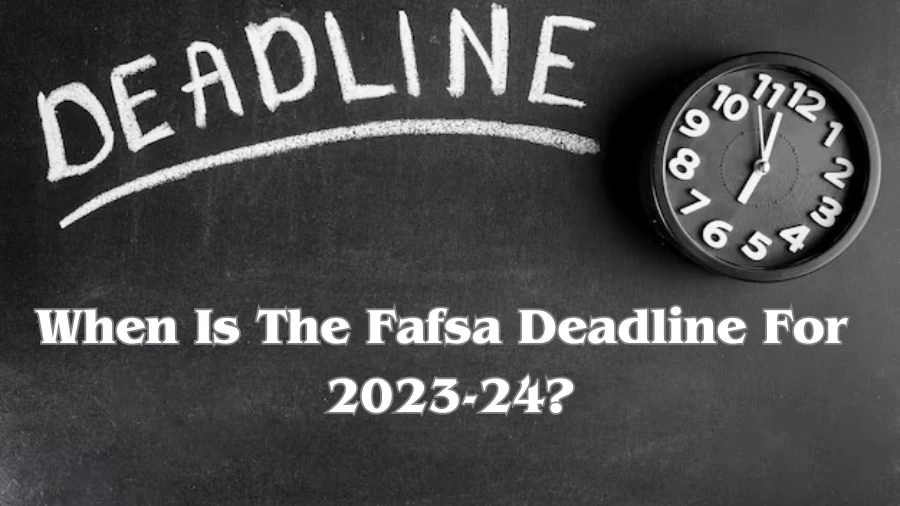
When is the FAFSA Deadline for 2023-24? When Does FAFSA Open for 2023-24?
The FAFSA deadline for 2023-24 is June 30, 2024, with early application recommended, as it calculates financial need by subtracting the Expected Family Contribution (EFC) from the Cost of Attendance (COA) to determine eligibility for various forms of aid.
by Sangamithra
Updated Sep 09, 2023
On This Page
When is the FAFSA Deadline for 2023-24?
The FAFSA deadline for the 2023-24 academic year is June 30, 2024. While this final date allows late submission, it's crucial to file early to maximize your chances of receiving financial aid, as certain programs and opportunities may be limited for late applicants. Additionally, individual states and colleges may have their own specific deadlines, so it's essential to be aware of those as well.
The FAFSA application for this academic year opened on October 1, 2022, and it's recommended to complete it as early as possible to ensure you don't miss out on available aid.
When Does FAFSA Open for 2023-24?
The FAFSA for the 2023-24 award year opened on October 1, 2022, and remains accessible until June 30, 2024, at 11:59 p.m. Central time (CT) for initial submissions. Any necessary corrections or updates to the FAFSA must be submitted by September 14, 2024.
However, it's essential to be aware that individual states and colleges may have their own earlier deadlines for financial aid applications, making it advisable to complete the FAFSA as soon as possible after October 1, 2022, to maximize eligibility for available aid.
When Does FAFSA Open for 2024-25?
The Free Application for Federal Student Aid (FAFSA) for the 2024-2025 academic year will open later than usual due to significant changes in the application process and processing system. Historically, the FAFSA becomes available on October 1st each year; however, for the 2024-25 academic year, it will not be accessible until sometime in December 2023.
Specific details regarding the exact opening date will be posted when officially announced. This delay is a result of the FAFSA Simplification Act, passed in 2020, which represents a substantial overhaul of federal student aid procedures, aiming to streamline the application process and enhance user experience while expanding eligibility and reducing barriers for various student populations.
What Is the FAFSA?
The Free Application for Federal Student Aid (FAFSA) is the official gateway to securing financial assistance for college education in the United States. Serving as a critical application form, the FAFSA enables students to apply for federal financial aid, including grants, work-study opportunities, and loans.
Beyond federal aid, numerous states, individual colleges, and universities also rely on the information provided in the FAFSA to make decisions regarding their own financial aid offerings. Essentially, the FAFSA serves as the foundational document that assesses a student's eligibility for various forms of financial support to help cover the costs of higher education.
How Does the FAFSA Operate?
The Free Application for Federal Student Aid, commonly known as FAFSA, plays a critical role in determining a student's eligibility for financial assistance to fund their college education. Here's an overview of how the FAFSA process works:
1. Determining Financial Need: The primary purpose of the FAFSA is to assess a student's financial need. To do this, the form collects comprehensive information about the student's and their family's financial situation, including income, assets, and other relevant financial data.
2. Expected Family Contribution (EFC): Based on the information provided in the FAFSA, the Expected Family Contribution (EFC) is calculated. The EFC represents the amount of money that the student and their parents are expected to contribute towards the cost of college each year. It's a crucial figure used by colleges, federal agencies, and other sources to determine the level of financial aid a student is eligible for.
3. Eligibility for Various Types of Aid: The FAFSA is the gateway to various forms of financial aid, including grants, work-study programs, and loans. The calculated EFC, along with other factors like the cost of attendance at the student's chosen college, is used to determine the type and amount of aid a student qualifies for.
4. First-Come, First-Served Basis: It's important to note that some financial aid is awarded on a first-come, first-served basis. To maximize their chances of receiving aid, students are encouraged to submit their FAFSA as early as possible. Many states and colleges have their own financial aid deadlines, which may be earlier than the federal deadline of June 30.
5. Changes in Terminology: Beginning in July 2023, the term "student aid index" (SAI) will replace EFC on FAFSA forms. This change aims to clarify that SAI represents an eligibility index for student aid rather than a reflection of a family's ability to pay for educational expenses.
6. Financial Aid Offer: Once a student is accepted by a college, they can expect to receive a financial aid offer. This offer typically includes a combination of grants, work-study opportunities, and loans. The specific components of the aid package can vary from college to college.
What Types of Financial Aid Can Be Secured Through the FAFSA?
Through the FAFSA (Free Application for Federal Student Aid), applicants can secure various types of financial aid to help cover the costs of their college education. These include:
Federal Grants: One of the primary forms of aid available through the FAFSA is federal grants. The most well-known federal grant is the Pell Grant, which is awarded to undergraduate students with demonstrated financial need. The specific grant amount varies based on factors like your Expected Family Contribution (EFC) and the cost of attendance at your chosen college.
Work-Study Employment: The FAFSA also provides access to the Federal Work-Study program. This program offers part-time job opportunities to eligible undergraduate and graduate students, allowing them to earn money to help pay for educational expenses while gaining valuable work experience.
Federal Student Loans: While federal student loans are not need-based, the FAFSA is still the gateway to accessing them. These loans often have lower interest rates and more flexible repayment terms compared to private student loans. There are different types of federal student loans, including subsidized and unsubsidized loans, as well as PLUS loans for parents.
State-Based Aid: Many states use the information from the FAFSA to determine eligibility for state-based financial aid programs. These state grants and scholarships can significantly reduce the overall cost of college for eligible students. Some state aid applications are integrated with the FAFSA, simplifying the process for applicants.
How to Apply for FAFSA?
How to Apply for the FAFSA: Step-by-Step Guide
Visit the Official Website: Go to the official FAFSA website, which is the United States government's platform for applying for financial aid.
Create an Account: If you're a first-time user, create an account on the website.
Complete the FAFSA Form: Fill out the Free Application for Federal Student Aid (FAFSA) form. It's a free process.
Check for Scheduled Maintenance: Be aware that the FAFSA form may be unavailable every Sunday from 3–11 a.m. Eastern time due to scheduled maintenance.
Know the Deadlines: Many states and colleges have priority deadlines for submitting the FAFSA form. There's also a federal deadline each academic year. Check and adhere to these deadlines.
Use the Federal Student Aid Estimator: If you're not ready to apply for aid or need help understanding your options, utilize the Federal Student Aid Estimator to assess your situation.
Review Your Application: Take time to review your FAFSA form and ensure accuracy.
Seek Help: If you have questions or encounter issues, explore the available FAFSA help resources on the website.
Renew Annually: Remember that you must submit a FAFSA form for each school year if you want to be considered for federal student aid.
Contact Support: If needed, you can contact the FAFSA support team for assistance or provide feedback.
How Does FAFSA Calculate My Financial Need?
FAFSA, or the Free Application for Federal Student Aid, calculates your financial need using a straightforward formula. It takes into account your financial information, and if you're a dependent student, your parent's financial information as well. Here's how the calculation works:
Expected Family Contribution (EFC): FAFSA determines your Expected Family Contribution (EFC) based on the financial data provided. This figure represents the amount the government expects you and your family can contribute towards your college expenses. Factors considered include your family's income, assets, and household size.
Cost of Attendance (COA): FAFSA then considers the total cost of attendance for your chosen college or university. This includes tuition, fees, room and board, textbooks, and other related expenses.
Financial Need Calculation: Your financial need is calculated by subtracting your EFC from the cost of attendance (COA). The formula looks like this:
Financial Need = Cost of Attendance (COA) - Expected Family Contribution (EFC)
When is the FAFSA Deadline for 2023-24? - FAQ
1. When is the FAFSA deadline for the 2023-24 academic year?
The FAFSA deadline for 2023-24 is June 30, 2024, but it's advisable to apply earlier for better chances of receiving aid.
2. When does the FAFSA open for 2023-24?
The FAFSA for 2023-24 opened on October 1, 2022, and remains accessible until June 30, 2024, but check state and college deadlines for early submissions.
3. How does FAFSA calculate financial need?
FAFSA calculates financial need by subtracting your Expected Family Contribution (EFC) from the Cost of Attendance (COA) of your chosen college.
4. What types of financial aid can FAFSA secure?
FAFSA can secure federal grants, work-study employment, federal student loans, and state-based aid to help cover college costs.
5. How do I apply for FAFSA?
To apply for FAFSA, visit the official website, create an account, complete the form accurately, and be aware of deadlines for your state and college.




